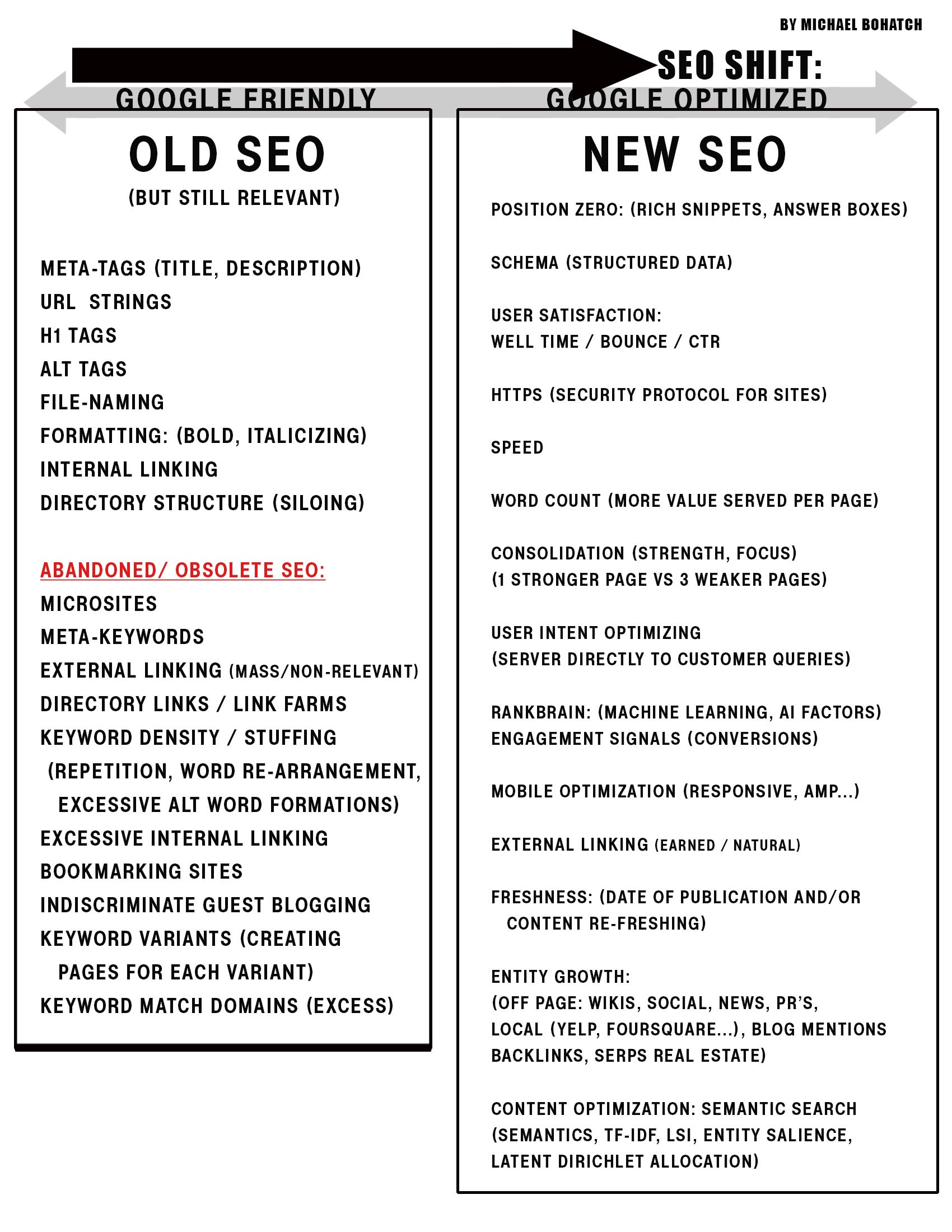
Welcome to another year SEO overview. The following information was collected, analyzed, summarized and constructed from many of the key SEO directives, changes, and directions over this past year. Rather than expecting you to review 100’s of articles, I thought it was more helpful just to cut to the chase with the most pertinent information. From this, you can gain some insight into how to move forward into 2018 and beyond
QUESTION
If search engines were to evolve into a 1 answer system?
(after your category has been determined)
PANDA = Animal?
PANDA = Restaurant?
PANDA = Algorithm update?
What best qualifies your page to serve up the 1 qualifying answer and result?
SEO has evolved. Writers should understand that GOOGLE FRIENDLY is a preliminary step to being GOOGLE OPTIMIZED. The following chart shows how factors have evolved and continue to evolve. As a rule, core SEO tactics (older) should continue for GOOGLE FRIENDLINESS, future tactics should be used for (newer) GOOGLE OPTIMIZATION. Though combining these factors makes your page (and sites) a force to be reckoned with. The key takeaway is to familiarize yourself with these factors and incorporate this train of thought into your writing and page/site creations.
GOAL?
Integrate some new ways of thinking about SEO and content creation
Begin to consider the implications of Semantic Search
Know that you will be outranked by competitors who offer more comprehensive answers
HOW IMPORTANT ARE KEYWORDS?
Keywords are not an end-all or something to ignore, as they are pertinent to your content to users. What has changed is that content will not survive solely on keywords, (such as keywords in meta information, thin keyword-based content, or keyword repetition tactics). Content should be driven towards user intent and query satisfaction to rank as a best answer to the queries. Keywords should be collected & studied for relevancy and voice bringing value and comprehensiveness to your content as a cohesive theme.
Words have moved on to become concepts in search
UNDERSTANDING SEMANTIC CONTENT FOR FUTURE (SEARCH ENGINE)
(Words & phrase relationship for better article and content construction!)
The following have been uncovered as prime contextual concepts being used for ranking the words on your page. These have been revealed per testing experiments, evidence produced, Google patents, and interviews (while not directly being communicated from Google itself).
1- KEYWORDS USAGE
(At a bare minimum, your page should contain the keywords you want to rank for, though not always an absolute as machine language grows smarter at dissecting unstructured data)
2- TF-IDF (Term Frequency-inverse document frequency)
Measures importance of how often a keyword appears compared to the expectations from a larger set of documents. Keywords are weighted in terms of quality instead of quantity (TF-IDF will tell you what keywords people frequently use, how frequently it appears and how significant it is to your website’s theme.) ref Google research
3- SYNONYMS AND CLOSE VARIANTS
(Close natural language and variations of words instead of keyword repetition. The Co-occurrence of relative words) Example: canine images, puppy pictures, dog photos……….
4- PAGE SEGMENTATION
(Where your words reside on the page carry more weight than others on a page, especially in a move towards mobile devices) (Ex: HTML body vs header, sidebar or footer)
5- SEMANTIC DISTANCE & TERM RELATIOSNHIPS
Relationships between phrases and words located in text (Ex: terms located in same paragraph may have closer relationship than those between text blocks) AKA: proximity of terms.
6- CO-OCCURRENCE & PHRASE BASED INDEXING
Looks at complete phrases and the prediction of other phrases that strengthen topic focus (AKA Google may expect you to talk about certain subjects, phrases mentioned, and words to achieve authority as compared to other authority documents) (add to this incoming links from relative pages pointing to the content)
7- ENTITY SALIENCE: (Entity: person, places, ideas & things)
Anything in a document that is distinct and well defined. Finding known relationships between entities (Such as: Entity Example: George Lucas, C3PO and Star Wars), Increases a page’s significance as your words/phrases are relative when compared to documents like yours. (The stronger an entity’s relationship to other entities on the page, the more significant that entity becomes.)
Evidence can be found in last year’s slide (2016), which was presented by Google’s search ranking engineer
SIMPLE BUT EFFECTIVE ANALOGY ref
If we want to rank well for “the rolling stones” it’s probably a really good idea to use words like “Mick Jagger,” “Keith Richards,” and “tour dates.” It’s also probably not super smart to use words like “rubies,” “emeralds,” “gemstones,” or the phrase “gathers no moss,” as these might confuse search engines (and visitors) as to the topic we’re covering.
Semantic search aims to improve search accuracy by understanding searcher intent, contextual meaning of terms, and relationships between words to provide more relevant search results. ref
“Semantic search systems consider various points including context of search, location, intent, variation of words, synonyms, generalized and specialized queries, concept matching and natural language queries to provide relevant search results” ref
In depth content tends to rank best in Google
_____________________________________________
TAKEAWAY: 2018 STEPS FOR SEO SUCCESS:
1- Core SEO: standards (meta-tags, urls, headings, alt tags, keyword research/content, internal linking – work directly with your SEO person/s to maintain this
2- Freshness (A Google patent factor)
Topicality scores include freshness, the age of the document, the number of links to and/or from the document (Google patent section 42)
The more often you update your content, the more often your site is crawled, increasing your opportunities to rank
NOTE: If your page doesn’t offer the latest and greatest information, you’re probably not the best source to provide an answer to my question. Expect to rank accordingly.
Advice:
– Renew, rewrite old ranking posts, articles and marketing pages
– Include the data that makes you relevant.
3- Content Length
Depth matters; shoot for 800-1000 words in your pages
More in-depth content will keep readers on your page longer and decrease bounce rates…
4- Mobile compliant (Mobile first index) – Google is moving towards your mobile-version of your page to be the true version over desktop. Check per this link
5- Answer Driven (user intent) (Q&A is becoming the new position 0 top result)
Not just answer, but likely supporting information searchers may also be looking for.
6- Optimize your website for Voice Search
The main difference between voice search and typewritten search is that typewritten queries are often short-form and are sometimes just the keywords themselves. Examples include:
- I want to know _______ • I want to go ______ • I want to do _______ • I want to buy7: User Satisfaction:
Measure and continuously improve user satisfaction with your site. (web analytics – bounce rates, CTR, performance (traffic, user time)) (Shift “content is king” analogy to “engagement is king”)
8: Most Important Anchor Text?
A study this year was conducted as to what form of anchor text link provides most value?
The answer was revealed as Page Title/Blog Post Title
9: Employ Schema.org Mark up (Structure your data)
“Google, Bing, Yahoo! and Yandex decided to join forces to develop a vocabulary to implement the HTML semantic markup of the web pages.” REF
10: Analytics
Analyze your content for strong and weak points (bounce rates, clicks, segment engagement)
This provides a road map into where you should be investing more time into.
STRATEGIES: COMPETITIVE ANALYSIS (Reverse engineering)
I’ve designed 2 basic strategies for competitive analysis, that I believe are key to reverse engineering your competition on the Internet. Each is designed to discover where user intent is and what’s working for your competitors. I believe these are 2 techniques that can be used again and again (every month, every year) to better match what you audience is searching for
(and a working process I have used for years to get quicker answers)
KEYWORD BASIS:
1 – Send your SEO person your keyword/s to determine who is ranking in the top 10
2 – SEO: Creates basic report of top ranking pages
3 – SEO / YOU: analyze their ranking page/s (landing page urls) to determine what they are doing that is winning (ranking for) user queries
COMPETITOR BASIS:
1 – YOU = Send your competitor’s list (competitor domains) to SEO (suggest starting with 1-3 recommendations)
2 – SEO: creates report of WHAT pages/KEYWORDS competitor is top ranking for
3 – YOU: create competitive content on your site to compete with competitors top ranking keywords/pages
(This is classified as seizing rankings or analyzing where user interest is for your competitor)
Note: Please reach out if you would like a report on your competitor’s top keyword rankings and/or top traffic producing pages (I recommend 1-2 competitors to start out with, before requesting more.)
I have a tool that helps to speed up the information gathering process.
SKYSCRAPER TECHNIQUE
The Skyscraper Technique is a content-driven technique for link building recently used by several SEO experts. It’s based on finding a good piece of content in your niche that is already considered a good resource and looking for ways to create slightly better content with the same message
To master topical relevance in the age of semantic search, in-depth analysis of your top-ranking competitors is essential. The common features among the best performing results (e.g., the concepts and terms most of them use in their content) will give you a good idea on how to cover a topic holistically to improve relevance and rankings. REF
FUTURE INSIGHT:
Trends point to 2 major content adjustments occurring in search engines now and in the future
1- The manual structuring of your data to help search engines understand your content better
(Schema.org method)
2- Better preparing your data (content) to be understood as Google scans unstructured data and classifies it
If this sounds familiar, it is because search engines are quickly becoming what IBM’s Watson is right now ref
FYI – FACTS & THOUGHTS
Google is now smart enough to figure out your page even without target keywords present
(however target keywords, semantic word relations make it easier)
Google has been rapidly employing machine learning in its algorithms
Machine learning factors:
USER INTENT- queries, ability to answer questions, relevancy
Understand meaning & extract insight from web content & unstructured data
Google is now using “reinforcement learning”
Reinforcement learning is an adaptive process in which an animal utilizes its previous experience to improve the outcomes of future choices. The Pygmalion team at Google is focused on improving Google’s understanding of natural language
The average “Dwell Time” for a Google Top 10 result is 3 min 10 sec
(Dwell time sends a signal back to Google (rankbrain) signifying higher user interest potentially giving boost to ranking)
Takeaway: Create a page that demands more time from users prompting more time investment
Note: Embedding videos into your content (from youtube) is a great way to increase user Dwell time
SEO is (NOT) dead: (a recap /re-clarification of this worn statement) See Article, Article_2

